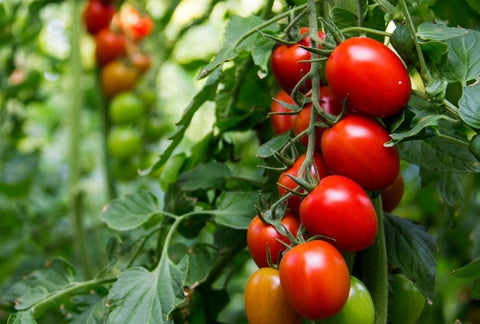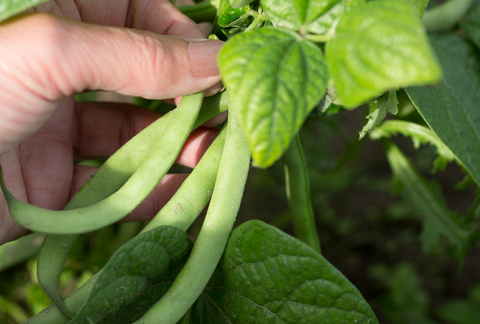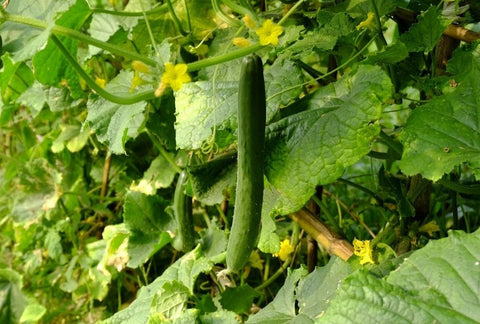Before working their way into almost every type of cuisine, tomatoes were only found in South America. Today, there are over 10,000 cultivated varieties!

Timing
Sprouts in 1-2 weeks. Harvest from Month 3 on.

Full sun
Equivalent of 7+ hours of direct sun [DLI of 21+ mol/m²/day].

Care
Intermediate. You’ll sprout, thin, prune, and pollinate.
Best Tomato Varieties to Grow Inside
There are over 10,000 varieties of tomatoes – so it’s hard to just recommend a few! We’ve screened the most popular container varieties for flavor, compactness, and indoor suitability.
The big decision you’ll have to make is between growing a vine or a bush… while they might not seem that different on the surface, there are surprisingly big implications!
Bush Types – Easier, Faster, and Lower Maintenance
These are also called “determinate,” because they only grow to a predetermined size. Once they reach a set size, they produce lots of fruit all at once, then start to decline. The benefit is that they don’t need to be pruned or trellised and are naturally tidier in a small grow space. Their downside is that they are shorter-lived and really only produce one good crop.
Red Robin
Cherry
This super-compact tomato comes from Japan – and tops out at 8” with an impressive yield.
Urban LeafTiny Tim
Cherry
They’re durable plants that can withstand tougher conditions, compact, and tasty!
Urban LeafBobcat
Full size
They’re durable plants that can withstand tougher conditions, compact, and tasty!
Urban LeafVine Types – Longer Lived with Continual Harvests
These will keep on growing – and producing tomatoes – as long as conditions are good (and are thus called “indeterminate”). As vines, they need support and regular pruning to stay contained, but we like how the tomato production is spread out and lasts for years. Bear in mind that these do best with a bit of space – and will gladly take over an entire window.
Husky
Cherry
They can take up a window (3-4 ft), but provide a continual harvest with minimal pruning.
AmazonSweet Baby Girl
Cherry
These need a trellis and pruning (unchecked they can grow 4 ft +) but provide continuous sweet tomatoes.
AmazonBest Setup for Tomato Plants
You’ll Need:
Planter:
Ceramic Self-Watering Planter (preferred) or a pot that is at least 8″ / 1 gal.
Soil:
Standard Potting Mix
Plant Food:
At the start: Herb Blend. This should be high in nitrogen (with NPK numbers like 10-5-5).
Ongoing: Vegetable Blend. This should be high in phosphorus and low in nitrogen (with NPK numbers like 4-10-6).
Grow Light:
A strong grow light that can give the equivalent of 7+ hours of direct sun [DLI of 21+ mol/m²/day].
Jump to: Our product recommendations
Preparing Your Planter & Watering Schedule for Tomato
Tomato plants do well in moist soil conditions. If the soil dries out completely, the roots will die back, and it will be tough for the plant to recover. On the other hand, if the roots are exposed to standing water for too long, they can rot.
A Ceramic Self-Watering Planter filled with a standard potting mix self-regulates to keep the soil at consistent moisture for your plant to thrive (and no watering guesswork for you).
To set one up:

- Fill up the planter with dry soil from the bag, gently tamping down the top.
- Dump the soil into a large mixing bowl and add water until the soil is moist, but not sopping wet (about ½ Cup)
- Mix in 1 tablespoon of the Herb Blend Plant Food.
If you are using a regular pot instead, it should be a little bit bigger (at least 8″ / 1 gal) and will need drainage holes to prevent it from being over-watered. Let the top of the soil dry out between watering.
Starting Your Tomato: Seed vs. Cutting vs. Nursery Plant
New Tomato plants can be started from seed, propagated from an established plant, or purchased live at many garden centers. We prefer to sprout from seed or propagate from a stem cutting, as it results in plants that are adapted to your growing conditions and limit the chances that you accidentally bring home pests.
How to Plant Tomato Seeds

Tomato grows quickly from seed. Plant 1 site in an 8″ / 1 gal container. In larger containers, space sites 8″ apart. For each site, plant 3 seeds 1/4 inch deep. Keep the soil warm (65-90°F, ideally 85°F). Sprouts typically appear in 10 days but can be as quick as 7 days or as long as 15 days depending on your conditions.
Propagating Tomato: How to Clone from a Stem Cutting

If you’ve already got a Tomato plant you love (or a friend does!), you can easily “clone” it with just sharp scissors and a clean glass of water. First, cut a couple of 6” shoots of new growth (avoid anything woody). Next, remove the lower leaves, so the bottom half is just stem. Place in a glass of 3” of water, making sure the cut leaf spots are underwater. Place the glass on a bright windowsill and change the water every few days. In a couple of weeks, roots should emerge and you can transplant them into your container. While using additional rooting hormones won’t hurt, it’s not necessary with Tomato plants.
- Cut 6” section of new growth
- Remove leaves halfway and place them in the water on a sunny windowsill
- Wait 7 days for a few ½ inch roots to form and carefully transplant into its final container
How to Transplant Tomato

Live starter plants give you a big jump start on your first harvest. When you’re in a garden center – pick the bushiest plant available (tall and lanky ones will be weak growers) and give it a good inspection for pests. Leaves should be dark green without holes, spots, or curled edges. A best practice is to actually “quarantine” your plant for about a week after bringing it home to make sure it’s free and clear of ride-on pests.
Ensuring it’s pest and disease-free it’s time to transplant your seedling into its final home.
- Remove some soil from its final planter – leaving enough space for the bottom of the seedling to be just higher than the soil surface. Then trim the bottom set of leaves – new roots will actually come out of these spots! (this step isn’t 100% necessary, but does tend to result in healthier tomato plants).
- Place in its final container, sure to have the cut spot buried. You can either bury deep or lean it to the side depending on what your planter will allow. Then fill around it with soil so that it’s tight, but not compacted.
Where to Grow Your Tomato Plants
Tomato plants have the highest light needs of any plant – so unless you have a totally unobstructed southern-facing window and plan on only growing in the summer – you’ll need a grow light. We still recommend taking advantage of your bright window (sunlight is free and great for plants!) and supplement it with a grow light. For an introduction to grow lights, head over to our post on grow lights for indoor gardeners. We’ve also got a buying guide for screw in types, but to keep things simple in this guide, we’ll just provide directions for the 24W Screw in Bulb by Sansi, which we think is a good middle-of-the-road option.

How Bright Should Your Grow Light Be?
Tomato plants need the equivalent of 7+ hours of direct sunlight [DLI of 21+ mol/m²/day] to grow their best. In order to provide an equivalent amount with a grow light, it needs to be pretty bright! The 24W Sansi bulb should be placed 6 inches away from the top of the plant. This will give your PPFD (the standard measure of brightness) of 500 μmol/m²/s.
How Many Hours Per Day Do Your Tomato Plants Need Under a Grow Light?
Tomato plants are known as “long-day” meaning that they develop faster with over 12 hours of light (and only need 6 hours of darkness to rest) so set your timer to light your plants for 14+ hours is best.
Tomato Plants Grow Faster in Warmer Temps
Tomato plants are called “warm-weather crops” and like temperatures right around 80. They will grow fine in conditions between 60 and 90°F but can lose their fruit if it drops below 40. On the other hand, if they are too hot, they will drop their blossoms, wilt, and stop ripening. Most homes are in a good range – and a south-facing sunny window can help get a plant the extra heat if needed.
Week 1-2: Check for Sprouts
You could see seedlings in as little as 7 days (though 10 days is more typical). If it’s been 15 days and you still don’t have any sprouts, it’s likely that your setup is too cold.
Week 3: Thin Your Seedlings

Thin your planter to only have 1 seedling per site – leaving the largest plant. If you are using the recommended planter (at least 8″ / 1 gal) this will mean you’ve got 1 plant after thinning. By getting rid of the smaller seedlings, you’re allowing the biggest and strongest one to flourish by reducing its competition for water, food, and space.
If your seedlings are under 2 inches, stretching out, or folding over, it’s likely that they don’t have quite enough light.
Month 3: How to Harvest Tomato
Tomatoes get sweeter and more flavorful when they ripen on the vine. During this ripening time, you’ll also reduce the amount of water that the roots get. Once they develop deep color and they come off the plant with a gentle pull, it’s time. It’s a bit more art than science, but if the first picked tomatoes aren’t flavorful enough, then just wait a little longer to try the rest. You’ll develop your feel in no time.
Month 6+: End of Life
If you are able to provide your plants with good light, nutrients, and proper pruning, you should be able to get a few harvests out of your plant. However, these varieties are determinate so they will eventually reach the end of their life.
Shop This Blog
The right supplies can take the guesswork out of caring for your plants – and turn care from a daily to weekly routine. Through our grow tests, we’ve found these products to produce the best indoor Tomato (and also have simple maintenance). Plants are adaptable and can grow in many different conditions, so they are by no means necessary if you already have other supplies.
Best Containers for Tomato: Ceramic Self-Watering Planters
Plants thrive on consistent moisture but can suffer if they’re waterlogged. A semi-porous ceramic self regulates ideal conditions. Our favorite is the COSWIP planter. Runner up is XS Self Watering Planter by Wet Pot.
Best Soil for Tomato: Standard Potting Mix
Tomato likes a rich and moist root zone – so you are best off with a standard potting mix – we like this Potting Mix by Rosy Soil.
Best Nutrients for Tomato: Balanced Blend followed by Vegetable Blend
Tomato likes to start with nutrients that are high in nitrogen (with NPK numbers like 10-5-5). For this Herb Blend, we recommend: Joyful Dirt All Purpose
Once they are growing, it’s better to use plant food that is high in phosphorus and low in nitrogen (with NPK numbers like 4-10-6). For this Vegetable Blend, we recommend: Joyful Dirt Tomato & Herb
Best Light for Tomato: DIY or Soltech
There is a very small chance that you have the bright windows needed to grow these without a grow light. If you are looking for a higher-end option – we love the Aspect Light by Soltech. For a more affordable option, a DIY setup using a 24W Screw-in Bulb by Sansi with a Clamp Light and Timer works well too. Check out our complete guide on a DIY setup for less than $40 or our buying guide for screw in bulbs.









There are no comments for this article. Be the first one to leave a message!